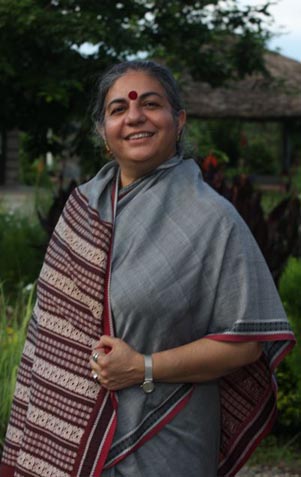March 21, 2014
 A Thought Leader Series Piece
A Thought Leader Series Piece
By Dr. Vandana Shiva
Note: March is Women’s History Month, a tribute to the generations of women whose commitment to nature and the planet have proved invaluable to society. Dr. Shiva, originally a theoretical physicist, is an environmental activist, author and expert in ecofeminism. She will present a Wrigley Lecture during the Fall 2014 semester.
Over the last four decades, I have served grassroots ecological movements, beginning in the 1970s with the historic Chipko (Hug the Tree) Movement, in my region of Central Himalaya. In every movement I have participated in, it was women who led the actions, and women who sustained actions to protect the earth and the sources of their sustenance and livelihoods.
Women of Chipko were protecting their forests because deforestation and logging was leading to floods and droughts. It was leading to landslides and disasters. It was leading to scarcity of fuel and fodder. It was leading to the disappearance of springs and streams, forcing women to walk longer and farther for water.
The dominant paradigm of forestry is based on monocultures of commercial species. Forests are seen as timber mines, producing timber, profits and revenue. The women of Chipko taught me and the world that timber, revenue and profits were not the real products of the forest. The real products were soil, water and pure air.
Today, science refers to these as ecological functions of ecosystems. Illiterate women of the Garhwal Himalaya were four decades ahead of the scientists of the world. By 1981, thanks to the actions of these women, the Indian government was compelled to stop logging in the Central Himalaya.
On Earth Day, 22nd April 2002, I was invited by women from a small hamlet called Plachimada in Palghat, Kerala, to join their struggle against Coca Cola, which was mining 1.5 million liters of water a day, and polluting the water that remained. Women were forced to walk 10 kilometers in search for clean drinking water.
Mayilamma, a tribal woman leading the movement, said they would not walk further for water. Coca Cola must stop stealing their water. The women set up a Satyagraha (Struggle for Truth) camp opposite the Coca Cola factory gates. Over the years I joined them in solidarity. In 2004, Coca Cola was forced to shut down.
Why do women lead ecology movements?
I believe it is because, in the sexual division of labor, women have been left to look after sustenance – providing food and water, providing health and care. When it comes to the sustenance economy, women are both the experts and providers.
Even though women’s work in providing sustenance is the most vital human activity, a patriarchal economy which defines the economy only as the economy of the marketplace, treats it as non-work. The patriarchal model of the economy is dominated by one figure – the GDP – which is measured on the basis of an artificially created production boundary (if you produce what you consume, you do not produce).
When an ecological crisis created by an ecologically blind economic paradigm leads to the disappearance of forests and water – and the consequent threat to life and survival – it is women who rise to wake up society and to defend the Earth and their lives. Women are leading the paradigm shift to align the economy with ecology. After all, both are rooted in the word “oikos” – our home.
Not only are women experts in the sustenance economy, they are experts in ecological science.
The rise of masculinist science with Descartes, Newton and Bacon led to the domination of reductionist, mechanistic science and a subjugation of knowledge systems based on interconnections and relationships. This includes all indigenous knowledge systems, and women’s knowledge.
The most violent display of mechanistic science is in the promotion of industrial agriculture, including GMOs as a solution to hunger and malnutrition. Industrial agriculture uses chemicals developed for warfare as inputs. Genetic engineering is based on the idea of genes as “master molecules” giving unidirectional commands to the rest of the organism.
The reality is that living systems are self-organized, interactive, dynamic. The genome is fluid.
As these issues move center stage in every society, it is the alternatives women bring through biodiversity and agroecology that offer real solutions to the food and nutrition crisis.
As I have learned over 30 years of building the movement Navdanya, biodiversity produces more than monocultures. Small family farms based on women’s participation provide 75 percent of the food eaten in the world. Industrial agriculture only produces 25 percent, while using and destroying 75 percent of the Earth’s resources.
When it comes to real solutions to real problems faced by the planet and people, it is the subjugated knowledge and work of women which show the way to the future.
About the author: Vandana Shiva, a world-renowned environmental thinker, activist, physicist, feminist, philosopher of science, writer and science policy advocate, is the Director of The Research Foundation for Science, Technology and Natural Resource Policy. She serves as an ecology advisor to several organizations including the Third World Network and the Asia Pacific People’s Environment Network.
In 1993 she was the recipient of the Right Livelihood Award, commonly known as the “Alternative Nobel Prize.” A contributing editor to People-Centered Development Forum, she has also written several works including, “Staying Alive,” “The Violence of the Green Revolution,” “Biopiracy: The Plunder of Nature and Knowledge,” “Monocultures of the Mind” and “Water Wars: Privatization, Pollution, and Profit,” as well as over 300 papers in leading scientific and technical journals.

